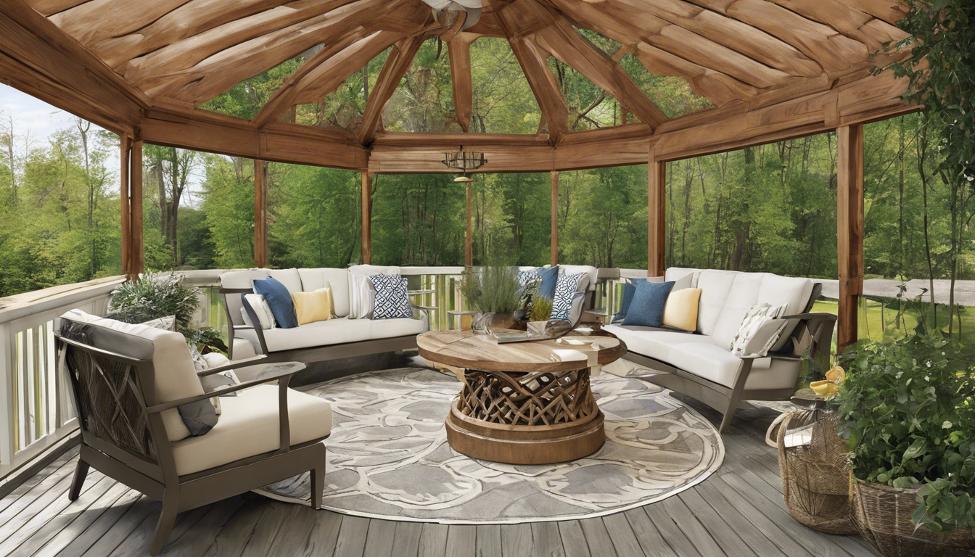
Transforming your backyard into a personal retreat is an adventure that many seek to embark on. Selecting the perfect enclosed gazebo ideas can play a crucial role in this transformation.
An enclosed gazebo not only adds an element of elegance and style to your outdoor space. It also provides a versatile area that can be used year-round, regardless of the weather.
This adaptable structure serves as a sanctuary where moments of solitude and social gatherings can merge seamlessly. Enhancing the quality of outdoor living while elevating the aesthetic appeal of your backyard.
Let’s explore various enclosed gazebo ideas that cater to a diverse range of needs and preferences.
From creating an edible plant wall that brings nature right to your doorstep. Also to designing a hobby room where creativity knows no bounds. The possibilities are virtually limitless.
We will also delve into converting your gazebo into a kid’s clubhouse, a spa retreat, or even a mini guest house to maximize the functionality and charm of your backyard sanctuary.
As we navigate through these ideas, remember that the ultimate goal is to create your perfect outdoor oasis that reflects your personal style and enhances your living space.
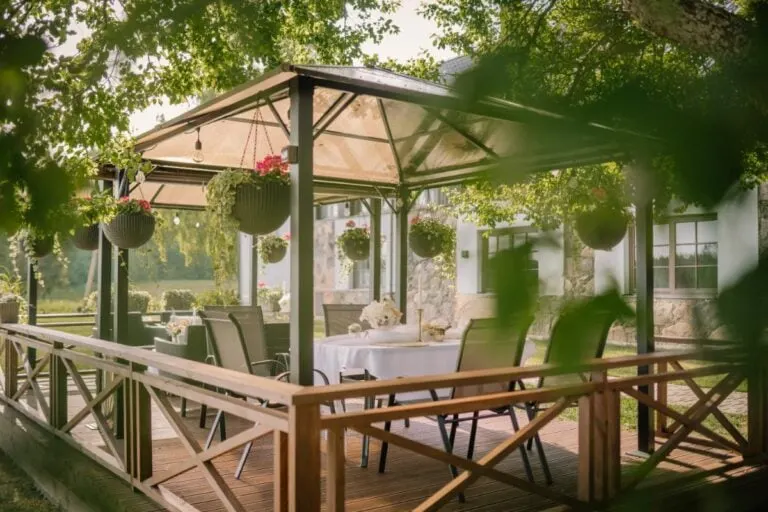
Can a Gazebo Be Enclosed?
Enclosing a gazebo transforms it from a simple outdoor structure to a versatile space that can be enjoyed throughout the year, regardless of the weather.
This section delves into the process and considerations involved in enclosing a gazebo, offering practical advice and insights drawn from various projects.
Initial Considerations and Planning
Before embarking on the project to enclose a gazebo, it’s crucial to measure the dimensions of the gazebo frame accurately. This includes the height, width, and depth of each section, ensuring that the materials chosen fit perfectly.
Choosing the Right Materials
The selection of materials is a pivotal decision in the process. Options range from glass panels, clear plastic panels, to screen panels, or a combination thereof. Factors such as cost, durability, and ease of installation should guide this choice.
Installation Process
Once the materials are selected, the next step is to attach the panels to the gazebo frame. This can be achieved using screws, clips, or adhesive, depending on the materials and the gazebo’s design.
Ensuring the panels are securely attached is vital for the structure’s stability and to prevent leaks.
Adding Doors and Windows
Incorporating doors and windows into the enclosed gazebo adds functionality and style. These can be pre-made or custom-cut into the panels, depending on the project’s requirements. Caution and adherence to safety guidelines are paramount when cutting panels to fit doors and windows.
Practical Insights from Real Projects
Real-life projects provide valuable insights into the process. For instance, replacing worn-out screens with hard plastic panels can significantly enhance the gazebo’s usability. Tinted panels on the southern side help in reducing UV rays and heat, making the gazebo cooler.
Squaring the gazebo and creating a frame for the panels are initial steps that ensure a snug fit and stability.
Finished Product and Usability
The end result of enclosing a gazebo should be a comfortable, wind-free space that can be enjoyed on rainy days or evenings. Adding features like spring hinges for doors and considering the placement of cross pieces for additional stability are details that enhance the overall functionality and aesthetics of the enclosed gazebo.
In conclusion, enclosing a gazebo is a feasible project that can significantly enhance the usability and appeal of outdoor spaces.
By following a structured process, from planning and material selection to installation and finishing touches, homeowners can transform their gazebos into cozy retreats for year-round enjoyment.
1. Edible Plant Wall
Benefits
Living wall installations are recognized as a prominent modern garden trend, especially when filled with edible plants, which add a significant aesthetic and functional value to any space.
These walls infuse energy and vibrancy into both indoor and outdoor areas without occupying excessive surface area, making them ideal for balconies, gardens, or patios.
The ability to grow fresh vegetables, herbs, and small fruits vertically offers numerous benefits including space-saving and cost-effectiveness, while also promoting a healthier living environment.
How to Build
Creating an edible plant wall involves several steps, each crucial for ensuring the sustainability and productivity of the garden.
Initially, one might consider using DIY approaches with upcycled materials like wood pallets or commercially available living wall kits that come with all necessary components for easy installation.
These kits often feature modular systems that can be adjusted to fit various spaces and include embedded containers for the plant’s root balls, allowing for an attractive display of foliage.
The choice of soil and understanding the weight it adds to the structure are important; standard potting soil is commonly used, but consulting with experts can ensure the wall supports the weight of soil-filled containers.
Ensuring adequate sunlight is crucial, as insufficient light may affect the growth of plants positioned lower on the wall. If necessary, shade-tolerant plants can be added to less exposed areas.
Irrigation is another critical aspect; a top-notch system is essential for the success of an edible living wall. Options include direct irrigation systems connected to a home water line or recirculating systems that conserve water by cycling it through the plant containers. Both systems can be enhanced with automated features for ease of maintenance, and some may include fertilization mechanisms to nourish the plants.
Finally, the selection of plants should consider their size and water needs to simplify the irrigation process.
Lightweight plants with smaller root balls are preferable for vertical growing. It is also beneficial to stagger planting schedules to enable continuous harvesting, and positioning larger, heavier plants at the bottom and lighter ones at the top helps maintain the structure’s balance and ease of care.
2. Hobby Room
Possible Uses
Gazebos are not solely for dining or entertaining; they also serve as excellent spaces for various hobbies and recreational activities. They provide an idyllic setting for reading, practicing yoga, or meditating, allowing individuals to engage in these activities in a peaceful, outdoor environment.
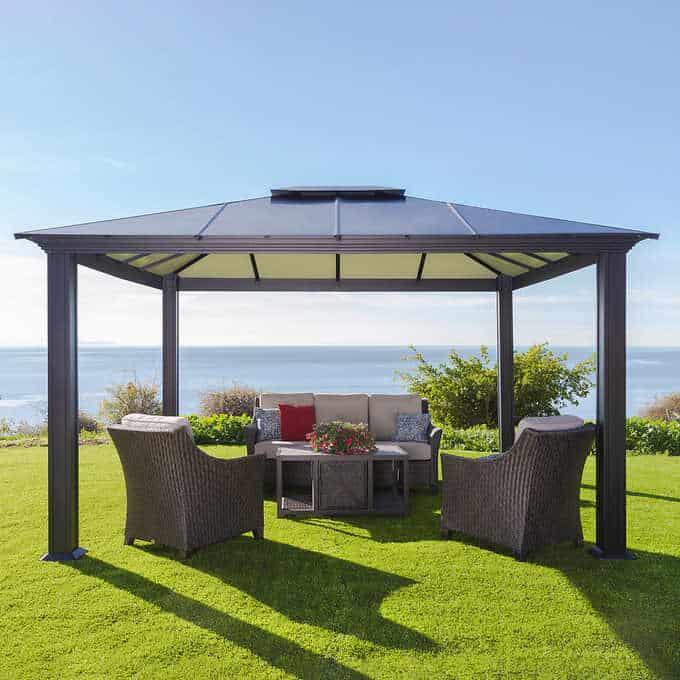
Additionally, gazebos are perfect for creative pursuits like painting and photography, offering a picturesque backdrop and tranquil atmosphere that can inspire artistic expression.
For music enthusiasts, gazebos create an intimate setting ideal for playing instruments or hosting small performances, enhancing the musical experience with natural acoustics.
Gardeners can also find joy in using gazebos to tend to plants, creating a vibrant garden space that can be admired and enjoyed from the comfort of the gazebo.
Furniture and Decor Ideas
To transform a gazebo into a hobby room, incorporating the right furniture and decor is essential. Adding an outdoor rug or deck tiles can significantly enhance the gazebo’s aesthetic, providing a finished look that is both stylish and functional.
Materials like polypropylene, sisal, or teak are recommended for their durability and weather resistance.
Seating options such as benches, chairs, swings, or hammocks can be sourced from local marketplaces like Craigslist or Facebook Marketplace, offering both comfort and a touch of personal style.
For added comfort, weather-resistant cushions and throw pillows can be included, and those skilled in sewing might consider making these themselves to reduce costs.
A small table with chairs can be set up for outdoor dining or socializing, while side tables next to seating areas are perfect for holding beverages or books.
Investing in outdoor tableware and glassware that are durable and less likely to break is also advisable for those who frequently enjoy their outdoor space.
To further enhance the ambiance, surrounding the gazebo with potted plants, hanging baskets, or climbing plants on trellises can add a natural and inviting element to the area.
In terms of lighting, string lights or fairy lights create a warm, welcoming glow, ideal for evening activities. Lanterns and candle holders can add a romantic touch, while solar-powered pathway lights offer an eco-friendly lighting solution.
For a more formal setting, consider installing chandeliers or pendant lights, and use uplighting or spotlights to highlight specific features like plants or sculptures, creating a visually stunning focal point.
3. Kid’s Clubhouse
Transforming a backyard space into a kid’s clubhouse can be an adventure that brings joy not only to children but also to adults. These personal havens offer kids a unique space to play, imagine, and grow.
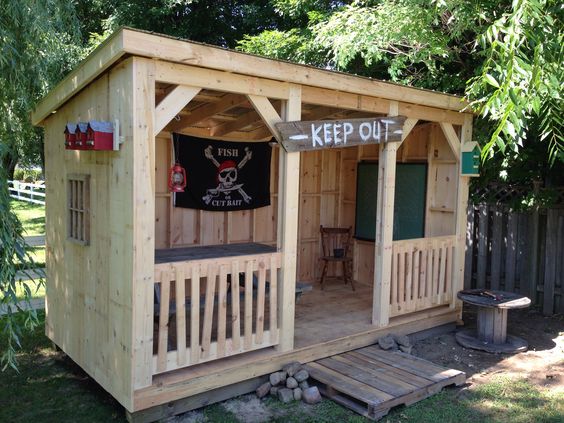
To ensure these clubhouses are both fun and safe, incorporating specific safety features and fun additions is crucial.
Safety Features
Safety should always be the top priority when creating a play space for children. The clubhouse should include walls in no activity areas to prevent accidental falls.
For areas with slides, ramps, or ladders that meet the deck of the clubhouse, installing a safety rail is essential. The rails should have rungs spaced about an inch to an inch-and-a-half apart to ensure safety without hindering play.
Additionally, any open spaces in the playset should be smaller than 3 1/2 inches or larger than 9 inches to prevent children from getting their heads stuck.
When choosing outdoor playground equipment, it’s vital to address safety issues that affect outdoor play areas. This includes selecting the right surfacing materials to mitigate hazards.
Options like rubber nuggets, wood mulch, rubber mats, poured-in rubber, and synthetic grass are available, depending on the type of equipment and aesthetic considerations.
Moreover, assessing the play area’s conditions to determine if additional safety measures, such as safety borders and shade structures, are needed is crucial. Consulting official government guidelines can help ensure that all equipment choices and safety measures meet current standards.
Fun Additions
Creating a clubhouse that children love involves more than just safety; it also requires fun additions that spark imagination and play. For instance, transforming a simple structure into a rustic cabin-style playhouse can give children a durable and engaging hideout.
Incorporating backyard playsets with high-quality cedar ensures longevity and provides kids a jungle gym right in their backyard. This not only saves countless trips to the park but also encourages kids to spend more time outdoors, away from screens.
To add to the fun, consider including creative elements within the clubhouse. Installing an IKEA plate shelf above a window can serve as a spot for books, slingshot pebbles for target practice, and other playthings.
Wooden shutters built by a family member add a personal touch and can be used for games like target practice with pebbles.
Moreover, decorating the clubhouse with favorite words or themes, like “WILDHOOD,” can inspire a sense of adventure and connection to nature. Running an extension cord to the clubhouse allows for the addition of a lamp or other electrically powered items, enhancing the space’s usability and comfort.
In conclusion, a kid’s clubhouse can be a magical addition to any backyard, offering a space for play, creativity, and adventure. By prioritizing safety features and including fun additions, parents can create a secure and exciting outdoor oasis that children will cherish for years to come.
4. Spa Retreat
Transforming a backyard into a serene spa retreat is a splendid way to create a personal oasis for relaxation and rejuvenation. A spa gazebo stands as the cornerstone of this transformation, offering a blend of outdoor enjoyment and comforting shade, crucial for those spa day activities that are best enjoyed without the harshness of direct sunlight.
Essentials to Include
To kickstart the ultimate backyard spa experience, certain essentials are paramount. A serene space dedicated to meditation sets the tone for relaxation.
For skincare enthusiasts, a face steamer introduces an easy and effective way to enjoy a spa skincare routine outdoors. These devices are not only relaxing but also promote circulation and prepare the skin to better absorb skincare products.
Caring for hands, feet, and nails is also an integral part of the spa experience. An 11-piece manicure tool set allows for a professional manicure session right in the comfort of one’s backyard.
This set includes hand masks with hydrating and exfoliating properties, a cuticle remover kit, and nail art tools for that perfect salon look.
For those with rough, dry feet, insulated booties lined with nourishing ingredients can make feet feel soft and smooth in just 10 minutes.
Adding a hot tub to the spa gazebo elevates the retreat to new levels of relaxation. The warm water not only soothes sore muscles but also triggers the release of endorphins, providing a calming effect that mimics the sensation of basking in the sun.
Design Tips
Incorporating a hot tub under the gazebo not only solves the challenge of finding the perfect spot for it but also provides year-round enjoyment regardless of weather conditions. This setup ensures privacy and adds a luxurious touch to the outdoor space.
For those seeking to enhance the ambiance, integrating lighting elements such as LED lights or lanterns can create a tranquil environment for evening relaxation.
Additional features like steps for easy hot tub access, towel racks, and seating areas contribute to the comfort and functionality of the spa retreat.
Decorative items and plants can further augment the spa-like atmosphere, and for an immersive experience, installing a sound system or a small outdoor heater can make the spa retreat enjoyable even during cooler months.
Fully enclosed gazebos with glass or screen windows provide both visibility and ventilation while ensuring maximum privacy. Such models extend the outdoor season, offering a cozy space protected from the elements, even when not using the spa.
Property’s value
For those on a budget, semi-enclosed or open-air gazebos can be outfitted with curtains, drapes, retractable screens, or greenery to create a secluded and intimate spa experience.
Hot tub gazebos not only serve as functional shelters for spa activities but also add a touch of elegance and style to the backyard. These structures can be chosen to complement the existing landscape or to become a focal point of the outdoor space.
The addition of a hot tub gazebo can significantly enhance the property’s value, making it an attractive feature for potential buyers.
In summary, creating a spa retreat in the backyard with a gazebo as its centerpiece offers a myriad of benefits, from enhanced relaxation and privacy to the aesthetic upliftment of the outdoor space.
By including essential spa tools and adopting thoughtful design tips, one can transform their backyard into a luxurious spa retreat that promises serenity and comfort amidst the beauty of nature.
5. Mini Guest House
Transforming an enclosed gazebo into a mini guest house offers a unique blend of privacy, comfort, and charm, making it an ideal retreat for visitors or a cozy hideaway for personal use.
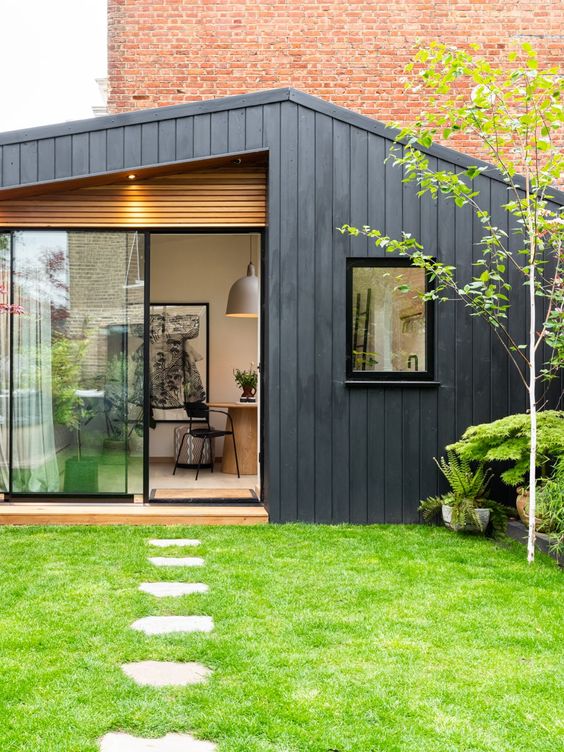
This section delves into the essential comfort features and seasonal concerns to consider when creating this inviting space.
Comfort Features
- Essential Amenities: To ensure guests have a relaxing and hassle-free stay, stocking the kitchen with basic necessities such as tea, coffee, sugar, salt, and cooking oils is crucial. These small touches make a significant difference in providing a warm welcome after a long journey.
- Entertainment Options: Including family-friendly board games can offer an enjoyable break from digital screens and foster memorable moments among guests. These games serve as an excellent form of entertainment for all ages, ensuring a pleasant stay.
- Fireplace for Warmth: In locations known for colder climates or near ski resorts, a fireplace becomes an essential feature, adding both warmth and ambiance. It enhances the overall guest experience, making the mini guest house a cozy retreat during winter.
- Heated Floors: Stepping onto a warm floor after a bath or shower adds a luxurious spa-like experience, especially in colder months. Heated floors are a thoughtful addition that significantly increases comfort for guests.
- Air Conditioning and Fans: For warmer seasons, ensuring the guest house is equipped with air conditioning or fans is vital for guest comfort. This allows for a refreshing environment where guests can relax and unwind.
- Mosquito Nets and Lights: Installing mosquito nets on windows or providing mosquito lights ensures guests a peaceful night’s sleep without the bother of insects. This is particularly important during the warmer months when insects are more prevalent.
Seasonal Concerns
- Building Durability: Guest houses, much like any outdoor structure, must withstand various weather conditions. Historical references show that gazebos have been constructed from materials ranging from marble in ancient Rome to cedar in modern designs, emphasizing the importance of choosing durable materials for longevity and minimal maintenance.
- Pest Control: Keeping bugs at bay is essential for an enjoyable outdoor experience. Strategies such as ditching mulch, planting repellent flora like chrysanthemums and marigolds, and maintaining a tidy landscape can significantly reduce the presence of unwanted pests in and around the guest house.
- Regular Maintenance: Just as with any outdoor structure, regular maintenance is key to preserving the beauty and functionality of the mini guest house. This includes cleaning gutters, preventing water stagnation, and ensuring outdoor dining areas are clean to avoid attracting insects.
- Protective Measures: In regions with extreme weather conditions, such as intense sunlight, heat, taking protective measures is crucial. Applying weather-resistant sealants, and maintaining greenery can help protect the structure and extend its lifespan.
- Seasonal Adjustments: Providing shade solutions during summer and removing excess weight, like snow or ice, in winter are practical ways to adapt the guest house to seasonal changes. These adjustments ensure the structure remains safe and enjoyable year-round.
Incorporating these comfort features and addressing seasonal concerns can transform an enclosed gazebo into a delightful mini guest house.
By focusing on the details that enhance guest comfort and ensuring the structure is well-maintained and adapted to weather conditions, homeowners can create a charming and functional retreat that adds value to their property and enriches their outdoor living space.
Conclusion
Throughout this exploration of transformative enclosed gazebo ideas, we’ve journeyed through the realms of creativity and practicality to unveil the potential of gazebos in enhancing outdoor living spaces.
From the sanctuary of edible plant walls, the versatility of hobby rooms, the magic of kids’ clubhouses, the serenity of spa retreats, to the charm of mini guest houses, each idea serves as a testament to the adaptability and allure of enclosed gazebos.
These concepts not only elevate the aesthetic and functional value of our backyards but also cater to a wide array of personal preferences and needs, promising a unique outdoor oasis tailored to individual styles and endeavors.
Reflecting on the broader implications, these enclosed gazebo ideas offer more than just an enhancement to personal living spaces; they invite us to reimagine the way we interact with our outdoor environments.
By integrating such innovative and personalized spaces into our homes, we not only contribute to the enrichment of our daily lives but also embrace the opportunity to connect with nature and those around us in meaningful ways.
As we consider these ideas, let us be inspired to transform our backyards into realms of endless possibilities, where moments of solitude and social engagement coalesce, fostering an enriched outdoor living experience that resonates with our aspirations and dreams.
FAQs
How Can I Turn My Backyard into an Oasis on a Budget?
To create an affordable outdoor oasis, start by adding decorative touches such as an outdoor rug, LED string or pendant lighting, and comfortable seating accented with throw pillows made from outdoor fabrics.
Integrate landscaping or potted plants and flowers to introduce color and life to the space. For a bohemian vibe, consider hanging a hammock, perfect for napping or enjoying a good book.
What Are Some Tips for Making a Gazebo Cozy?
To enhance the coziness of your gazebo or pergola, consider these additions:
- Lighting: Install lights to create a warm, inviting atmosphere.
- Heat: Adding a heat source will allow you to enjoy the space even when the temperature drops.
- Curtains: Hang quality curtains for added privacy and a touch of elegance.
- Roof: If you have a pergola, adding a roof can transform it into a more sheltered and cozy space.
What Is the Ideal Shape for a Gazebo?
When choosing a gazebo, the three primary shapes to consider are octagon, rectangle, or oval. The best shape depends on your intended use.
For example, an oval gazebo is ideal if you plan to include an outdoor sofa, love seat, club chairs, and a gas fire pit. While octagon gazebos range in size from 8′ x 8′ to 20′ x 20′, the most common size is 12′ x 12′.
How Can I Revamp My Outdoor Area?
Transforming your outdoor area involves several key steps:
- Enhance Entries: Make your entryways inviting and accessible.
- Sharpen Edges: Clean and define the edges of paths and garden beds.
- Soften Hardscapes: Use plants or soft materials to balance out hard surfaces.
- Vertical Gardening: Utilize walls for climbing plants or vertical gardens.
- Mass Planting: Plant in groups for a more impactful and cohesive look.
- Layer Planting: Create a lush appearance by layering plant beds with varying heights.
- Frame Views: Use plants or structures to frame and highlight specific views.
- Focus on Foliage: Give as much attention to foliage as to flowers for a garden that remains interesting throughout the seasons.
[…] Enclosed Gazebo Ideas: Create Your Perfect Outdoor Oasis […]